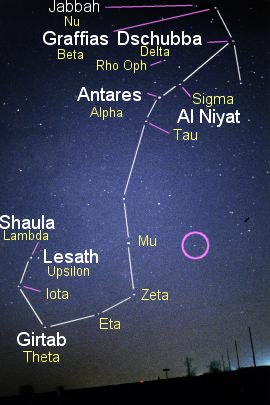 A single "Jupiter" orbits a star that seems much like the Sun
though with curious anomalies.
A single "Jupiter" orbits a star that seems much like the Sun
though with curious anomalies.
THE PLANET
The circle shows the location of the class G dwarf star HR 6094,
found in the constellation Scorpius.
The star's planet orbits with a period of 540.4 days, or 1.48
years, at an average distance of 1.26 Astronomical Units (189
million kilometers, 117 million miles), 26 percent greater than the
Earth's path around the Sun, the stellar motion revealing a planet
with a mass at least as great as Jupiter's. A rather high
eccentricity takes the planet from as far as 1.92 AU from its
parent star to 0.60 AU, closer to its star than Venus is from the
Sun.
|
 A single "Jupiter" orbits a star that seems much like the Sun
though with curious anomalies.
A single "Jupiter" orbits a star that seems much like the Sun
though with curious anomalies.
 A single "Jupiter" orbits a star that seems much like the Sun
though with curious anomalies.
A single "Jupiter" orbits a star that seems much like the Sun
though with curious anomalies.